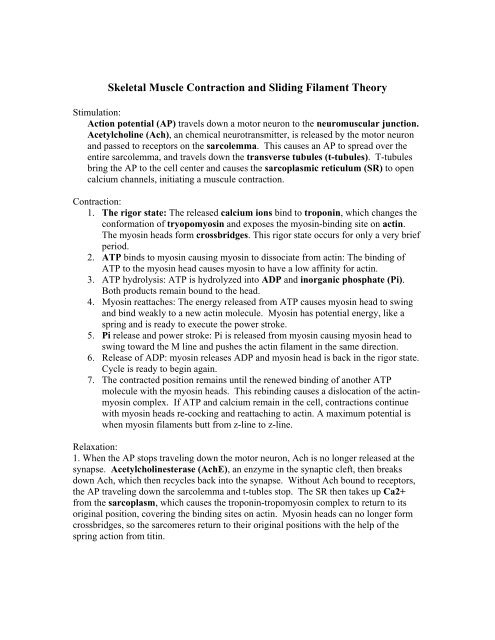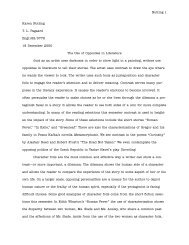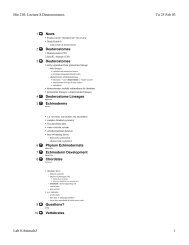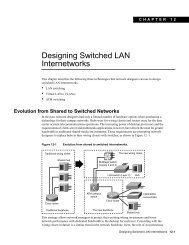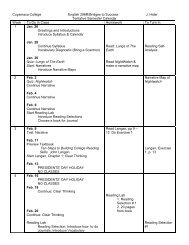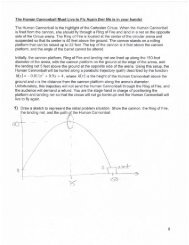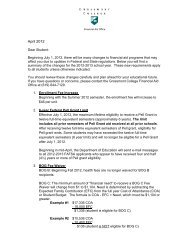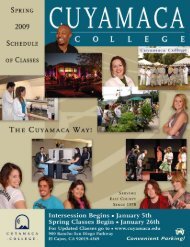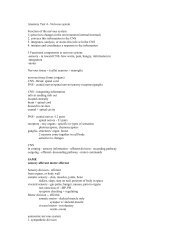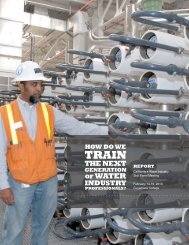Muscle Study Guides AXIAL MUSCULAR SYSTEM LAB Head ...
Muscle Study Guides AXIAL MUSCULAR SYSTEM LAB Head ...
Muscle Study Guides AXIAL MUSCULAR SYSTEM LAB Head ...
You also want an ePaper? Increase the reach of your titles
YUMPU automatically turns print PDFs into web optimized ePapers that Google loves.
Skeletal <strong>Muscle</strong> Contraction and Sliding Filament TheoryStimulation:Action potential (AP) travels down a motor neuron to the neuromuscular junction.Acetylcholine (Ach), an chemical neurotransmitter, is released by the motor neuronand passed to receptors on the sarcolemma. This causes an AP to spread over theentire sarcolemma, and travels down the transverse tubules (t-tubules). T-tubulesbring the AP to the cell center and causes the sarcoplasmic reticulum (SR) to opencalcium channels, initiating a muscule contraction.Contraction:1. The rigor state: The released calcium ions bind to troponin, which changes theconformation of tryopomyosin and exposes the myosin-binding site on actin.The myosin heads form crossbridges. This rigor state occurs for only a very briefperiod.2. ATP binds to myosin causing myosin to dissociate from actin: The binding ofATP to the myosin head causes myosin to have a low affinity for actin.3. ATP hydrolysis: ATP is hydrolyzed into ADP and inorganic phosphate (Pi).Both products remain bound to the head.4. Myosin reattaches: The energy released from ATP causes myosin head to swingand bind weakly to a new actin molecule. Myosin has potential energy, like aspring and is ready to execute the power stroke.5. Pi release and power stroke: Pi is released from myosin causing myosin head toswing toward the M line and pushes the actin filament in the same direction.6. Release of ADP: myosin releases ADP and myosin head is back in the rigor state.Cycle is ready to begin again.7. The contracted position remains until the renewed binding of another ATPmolecule with the myosin heads. This rebinding causes a dislocation of the actinmyosincomplex. If ATP and calcium remain in the cell, contractions continuewith myosin heads re-cocking and reattaching to actin. A maximum potential iswhen myosin filaments butt from z-line to z-line.Relaxation:1. When the AP stops traveling down the motor neuron, Ach is no longer released at thesynapse. Acetylcholinesterase (AchE), an enzyme in the synaptic cleft, then breaksdown Ach, which then recycles back into the synapse. Without Ach bound to receptors,the AP traveling down the sarcolemma and t-tubles stop. The SR then takes up Ca2+from the sarcoplasm, which causes the troponin-tropomyosin complex to return to itsoriginal position, covering the binding sites on actin. Myosin heads can no longer formcrossbridges, so the sarcomeres return to their original positions with the help of thespring action from titin.


